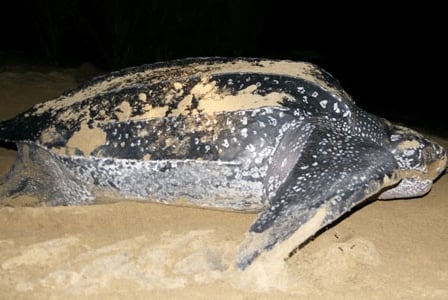
Learn about the amazing leatherback sea turtle – an underwater giant thats gravely endangered.
In our second Wildlife Wednesday blog post (check out our first Wildlife Wednesday post about the endangered Sumatran tiger here), we highlight the amazing leatherback sea turtle—an underwater giant that’s gravely endangered.
Habitat: Throughout the oceans, in open water, as well as along coastal regions.
Leatherback sea turtle trivia
- The leatherback is the largest sea turtle in the world, measuring more than six feet lengthwise. In fact, they’re one of the world’s largest reptiles! The World Wildlife Fund (WWF) refers to them as underwater giants.
- They’re also the deepest diving out of all the sea turtles and have the widest range; they have been known to travel across entire ocean basins while migrating. For example, a population that nests in Indonesia can travel to the China Sea, the coast off the US, and Australia.
- They travel long distances to forage for their favourite food—jellyfish.
- The name “leatherback” comes from its skin, which has the appearance of being soft and leathery, not hard like other sea turtles’ shells.
- Even though they’re reptiles, they can regulate their body temperatures to stay warm in very cold waters.
- They may have swum with the dinosaurs—the species is estimated to be 100 million years old!
Why they’re threatened
Leatherbacks aren’t just the largest or most travelled sea turtle—they’re also the most endangered. The number of leatherbacks has fallen by more than 90 percent since 1980, and there are only about 34,000 nesting females remaining. A 2004 study reported that they could become extinct in 10 years—2014.
A new multi-researcher, multi-university study published in Ecological Applications mapped the Pacific leatherback’s route with high-tech satellite technology and identified high use areas in the Pacific Ocean due to fishing. These areas are referred to as potential “danger zones” for the turtle, as they can get caught in fishing gear as bycatch. Because these turtles have such a long and extensive migration, they are more vulnerable to threats in the oceans, such as fishing.
Why we need them
Leatherback turtles are very important to the food chain, and they help to keep the jellyfish population in check. If they were to become extinct, the jellyfish may reach much higher numbers. It has also been argued that leatherback turtles are indicators of the health of the oceans in general.
How you can help leatherback sea turtles
The Ecological Applications study aims to use its findings to better protect these amazing animals, and the WWF is also engaging in efforts to protect them.
As for individuals, choosing sustainable seafood minimizing the risk of bycatch, which will help not only leatherbacks, but also other marine animals, such as endangered sharks and dolphins.

